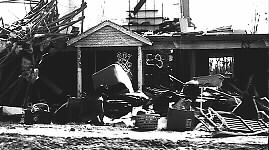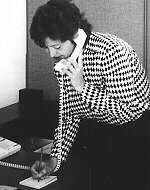By Martha Seagram
“What do you mean they LOST their home?!?!? How does someone LOSE their home?!?” I remember clearly those were my words in the early morning of April 9, 1999, when someone called me on the prayer chain from St. Barnabas to say that Clark and Susan Crabill had “lost their home.” I had slept through the tornado siren. Dave had heard it, done his investigation to his satisfaction and decided that we could continue sleeping, so I hadn’t even realized there had been a storm—let alone a tornado that tore through Montgomery devastating the lives of many friends. The worst hit areas were Harper’s Point and near Sycamore High School.
My first instinct as Senior Warden was to call Father Hill, but he was already “boots on the ground,” as responding to emergency situations has always been his strength. Next, I called the Junior Warden Terri Thornton, and we decided to meet at church and brainstorm what we thought we could do to help—and to pray. It wasn’t long before we heard that Steve and Jill Cole had also lost their home; this time, I knew what that meant.
Much of the rest of that day and following weeks were a blur—prioritizing in an emergency was not my strength and feelings of inadequacy were very strong. However, there were two individuals, Terri Thornton and Carolyn Wolfe, who had the perfect gifts and they took over. I had a vacation planned a couple weeks after the tornado and even though I felt guilt for leaving, at the same time I knew that things were in extremely capable hands. Terri was the big picture thinker with an event-planning background, and Carolyn knew how to execute the myriad of details. A God-given team!
Shown above, one of the many destroyed homes in Montgomery. Below is Martha Seagram, senior warden in 1999, taking notes of things that needed to be done.
I spoke with Carolyn to reminisce, and she recalls vividly the dichotomy of those who were horrified and truly wanted to help versus those who were just curious and were little more than voyeurs. Another ongoing challenge was discerning the difference between what help you thought someone needed and what help someone would accept. These were challenges she and Terri navigated daily. As she reminded me, texting and social media weren’t the order of the day; news spread more slowly, and it took awhile to grasp the enormity of the situation. In fact, Carolyn’s husband had an early flight from Cincinnati to New York on April 9 and didn’t realize until he reached New York the extent of what had happened. He only knew that the power was out at their home. Once in New York, he turned around and caught a flight back.
I would like to share some of my random memories from that time.
Other parishioners showing up at church knowing we needed to do something—but what?!?
Many other parishioners had major tree damage and needed help.
Finding out that Father Hill had been out searching for short-term housing or hotels or any place that his parishioners could have a roof over their heads.
Realizing we were a central place for volunteers to come and help and that organization would be needed. Ken Preglow set up his computer and got to work developing a database to coordinate volunteers with locations that needed volunteers. St Barnabas became an organizational hub as teams of people checked in at St Barnabas and then went out to help clean up, cut down trees, whatever they could do.
Sharon Givan worked for a year as a Tornado Relief Coordinator. With her background in counseling, she was also able to provide essential emotional support that was a large part of the healing process.
Teams of people arrived daily from neighboring communities as well as from other states. Help poured in from all directions, and yet I still felt it would never be enough. A tornado hot line was set up at the church, and Terri and Carolyn matched up the helpers with the needs. Eventually, the Red Cross pointed out that we were not insured for such an operation. Carolyn recalls spending every weekend for at least six months cutting down trees and that chain saws were the most sought-after commodity.
Bottled water was also not as readily available, so many coolers of water were delivered daily to the area.
Donald Murray used his charm and Scottish brogue to solicit donations of boxes from local corporations, so that as families found items to salvage in the rubble, they had a box to put them in.
Donations started pouring in, and the undercroft soon looked like the beginning of a rummage sale with piles of clothing to sort and also canned food.
School teachers called to see if their children could make cards to be distributed to the community. Of course, that made me cry.
Survivor guilt is a real thing. So is PTSD.
Money was donated and as much as I was thankful, I remember to this day feeling so terribly inadequate signing a check for a couple of hundred dollars to give to a family who I knew had lost everything. What difference could that make??? The Red Cross held meetings weekly for updates and information; unfortunately, it was too late when St Barnabas leadership realized that money donated by local residents to the Red Cross because of this disaster was not going in totality to help this disaster but rather just a portion of it. Hard news to swallow.
Bob Gustafson made it a personal challenge to follow up with insurance companies who weren’t responding as quickly as he felt they should.
Driving in the area and seeing a home completely untouched with someone mowing their lawn beside rubble that used to be a home.
The postal service trying to deliver mail to homes that were gone.
A significant positive step was taken as a result of this tragedy. Bishop Herb Thompson approved a donation of $50,000 for an urban search and rescue truck for county wide use by the USAR Task Force. Emergency responders were heroic, committed, and capable but perhaps more will be done sooner due to having better equipment in the future. The following is taken from a letter from Father Hill to the Bishop at that time: “Their work in the City of Montgomery was truly heroic. Many lives were saved and their expertise was of great merit to the city and especially to the victims. As I believe you saw when you visited the tornado site, this team is working out of a rented truck. I indicated to you at the time of your visit that their response could have been much quicker and even more productive had they had an emergency vehicle "at the ready," with the necessary tools and equipment accessible.”
Although we pray that this will never happen again, we are thankful for the generosity of the Diocese.
Another positive thought came from Carolyn Wolfe (Stephens) who believes that the experience opened many doors for her to serve the Lord both at church and in the community.
But for me, 20 years later, I remember most vividly seeing the power of nature and praying that God’s power to restore was even greater. Over the next weeks, the Crabills and Coles are going to share some of their memories from this time.



